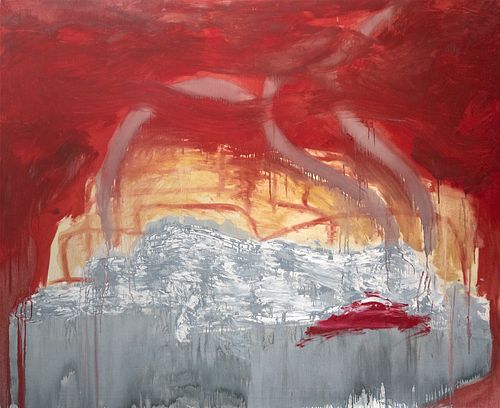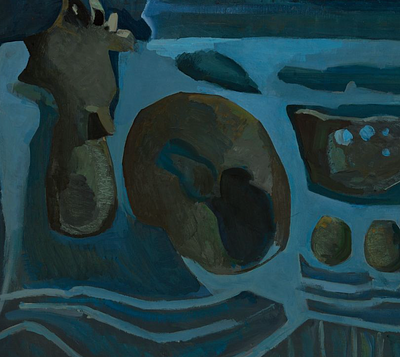JOSÉ MANUEL BROTO GIMENO (Zaragoza, 1949). Untitled, 1984. Acrylic on canvas.
Lot 72
About Seller
Setdart Auction House
Carrer Aragó 346
Barcelona
Spain
Setdart Subastas was born in 2004 and is currently the first online art auction in Spain with solidity, prestige and reliability guaranteed by our more than 60,000 users. Setdart has a young, dynamic and enterprising team ready to successfully manage the purchase and sale of art works through custom...Read more
Estimate:
EUR€16,000 - EUR€18,000
$17,204.30 - $19,354.84
Absentee vs Live bid
Two ways to bid:
- Leave a max absentee bid and the platform will bid on your behalf up to your maximum bid during the live auction.
- Bid live during the auction and your bids will be submitted real-time to the auctioneer.
Bid Increments
| Price | Bid Increment |
|---|---|
| EUR€0 | EUR€10 |
| EUR€200 | EUR€25 |
| EUR€500 | EUR€50 |
| EUR€1,000 | EUR€100 |
| EUR€3,000 | EUR€200 |
| EUR€5,000 | EUR€500 |
| EUR€10,000 | EUR€1,000 |
| EUR€20,000 | EUR€2,000 |
| EUR€50,000 | EUR€5,000 |
About Auction
By Setdart Auction House
Jul 27, 2021
Set Reminder
2021-07-27 08:00:00
2021-07-27 08:00:00
America/New_York
Bidsquare
Bidsquare : CONTEMPORARY AND ACTUAL ART
https://www.bidsquare.com/auctions/setdart-auction-house/contemporary-and-actual-art-7261
Setdart Auction House sofia@setdart.com
Setdart Auction House sofia@setdart.com
- Lot Description
JOSÉ MANUEL BROTO GIMENO (Zaragoza, 1949). Untitled, 1984. Acrylic on canvas. Signed and dated on the back. Size: 159 x 194 cm. In this work the author uses an abstract language, based on the irregular geometry, of organic character as much in its outline as in its textures and colors, to construct an image that has much of archaic ritual, as much in its outline as in its colors. It is an open style, whose basic characteristic is the conception of the pictorial surface as a whole, as an open field, without limits and without hierarchy. Thus, as we see here, the pictorial forms are the result of a thoughtful composition and experimentation, with an image of gestural character, are not limited to a composition but go beyond, indicating to the viewer that it is about forms, ideas or suggestions that go beyond the boundaries of the purely pictorial. Aragonese painter framed within the new abstraction of the seventies, being considered one of the most significant figures of contemporary Spanish painting. José Manuel Broto studied at the School of Arts and Crafts in Zaragoza, and exhibited his work for the first time in 1968, showing a style in line with constructivism. In 1972 he moved to Barcelona, where he founded the Trama group. However, after the dissolution of the group, Broto entered a language close to abstract expressionism, which incorporates into his work a landscape of primitive nature. He will show these new works in his first solo exhibition in Paris, held in 1984 at the Adrien Maeght gallery. Since 1985 he lives and works in Paris. Settled in Paris, he immediately overcame the so-called "abstract impressionism" stage of the early eighties and freed himself from the elements that, after his trip to Italy (1982), were added to his iconographic and chromatic repertoire, resulting in a series of paintings with a markedly romantic tone. After ten years in the French capital, during which he coincides with other Spanish artists such as Barceló, Campano or Sicilia, he moves to Mallorca. With the use of large formats, the next step in his work is the recovery of an abstraction of strong chromatic content and the advance in the spatial definition in his canvases, as shown in Capricho (1987) or La misión (1988). He has been awarded the National Prize of Plastic Arts (1995), in 1997 he was awarded the ARCO Prize of the Critics Association, and in 2003 the Aragón Goya Prize for Engraving. In 1995 the Reina Sofia Museum in Madrid dedicated a retrospective exhibition to him. He is currently represented in the Museo de Arte Abstracto Español de Cuenca, the FRAC (Midi-Pyrénées, France), the Chase Manhattan Bank Collection in New York, the Juan March Foundation, the Reina Sofía, the Metropolitan Museum in New York, the Fond National d'Art Contemporain in Paris, the Kampo Collection in Tokyo, the Tàpies Foundation in Barcelona, the DOVE Collection in Zurich, the Ateneum in Helsinki, the Peter Stuyvesant Foundation in Amsterdam, the Maeght in France, La Caixa in Barcelona, the Preussag in Hanover and the IVAM in Valencia.
- Shipping Info
-
In-house shipping available. Please inquire at admin@setdart.com.
-
- Buyer's Premium



 EUR
EUR CAD
CAD AUD
AUD GBP
GBP MXN
MXN HKD
HKD CNY
CNY MYR
MYR SEK
SEK SGD
SGD CHF
CHF THB
THB
















